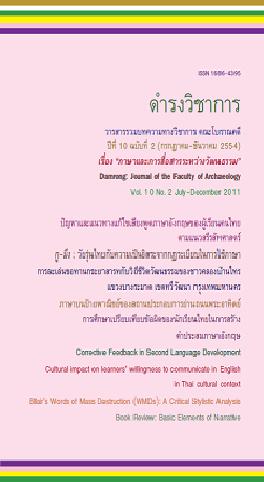THAI LEARNER PROBLEMS: GUIDELINES BASED ON ARTICULATORY PRONUNCIATION
Keywords:
การออกเสียง, สรีรสัทศาสตร์, ภาษาอังกฤษAbstract
Speaking has always been an important means of human communication. To communicate successfully, it is necessary to use accurate speech sounds. Second language communication requires accurate speech sounds as well because a speaker’s mispronunciation can easily change the messages they are conveying. To improve Thai learners’ English pronunciation, it is therefore necessary to provide them with some background in articulatory phonetics. This will give them basic guidelines in articulation which will help them to better differentiate English problem sounds and thus enable them to improve their English pronunciation. Necessary basic concepts based on articulatory phonetics are as follows: (1) speech organs responsible for producing speech sounds; (2) criteria for producing accurate consonant sounds according to the places of articulation, manners of articulation and voicing; (3) criteria for producing accurate vowel sounds according to the position of the tongue and the lips; (4) the use of suprasegmental phonemes to accompany the consonant and vowel sounds in English; (5) sound assimilation of the English loan words used in Thai. Finally, learning motivation should be enhanced for the second language learners along with their theoretical knowledge of speech sounds.
References
Crystal, D. (1989). Linguistics. London: Pelican Books.
Fromkin, V., Rodman, R., & Hyams, N. (2003). An introduction to language. (7th ed.) Boston: Thomson Corporation.
Handschuh, J., & Simounel, A. (1985). Improving oral communication. EnglewoodCliffs: Prentice-Hall, Inc.
Hornby, A.S. (2005). Oxford Advanced Learner’s Dictionary. (7th ed.) Oxford: Oxford University Press.
Ian, R.M. (1978). Introducing practical phonetics. Boston: Little, Brown and Company Inc.
Lane, L. (1997). Basics in pronunciation: Intermediate practice for clear communication. White Plains: Addison Wesley Longman.
Lane, L. (2005). Focus on pronunciation 3. New York: Pearson Education.
McKechnie, J. (1983). Webster’s new twentieth century dictionary. (2nd ed.). New York: Prentice Hall Press.
Orion, G. (1997). Pronouncing American English: Sounds, stress, andintonation. (2nd ed.) New York: Heinle & Heinle Publisher.
Piaget, J. (1950). The psychology of intelligence. New York: Routledge.
Prator, C.H. & Robinett, B.H. (1972). Manual of American English pronunciation.(3rd ed.) New York: Holt, Rinehart and Winston, Inc.
Prator, C. & Celce-Murcia, M. (1979). An outline of language teaching approaches. In Celce-Murcia, Marianne, and McIntosh, Lois (ed.), Teaching English asa Secong or Foreign Language. New York: Newbury House.
Sapir, E. (1921). Language: An introduction to the study of speech. Harcourt: Brace & World, 1921.
Wells, J.C. (1995). Longman Pronunciation Dictionary. Essex: Longman Group UK Ltd.
University of Arizona (2010). The language sample project (LSP). Retrieved8 August 2010 from http://www.ic.arizona.edu/~lsp/
University of Iowa (2010). The phonics flash animation project. Retrieved 8 August2010 from http://www.uiowa.edu/~acadtech/phonetics/
Downloads
Issue
Section
License
บทความนี้เป็นผลงานของข้าพเจ้าแต่เพียงผู้เดียว และ/หรือเป็นผลงานของข้าพเจ้าและผู้ร่วมงาน ตามชื่อที่ระบุในบทความจริง และเป็นผลงานที่มิได้ถูกนำเสนอหรือตีพิมพ์ที่ใดมาก่อน





